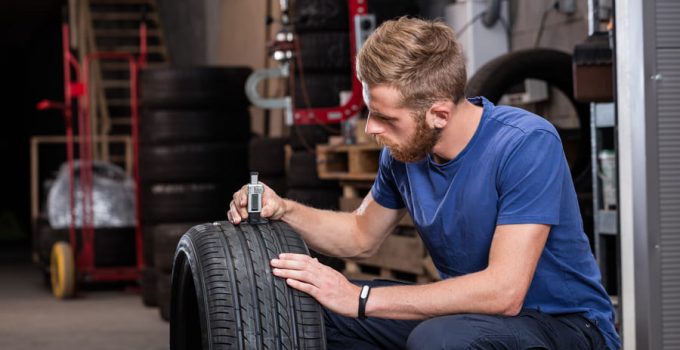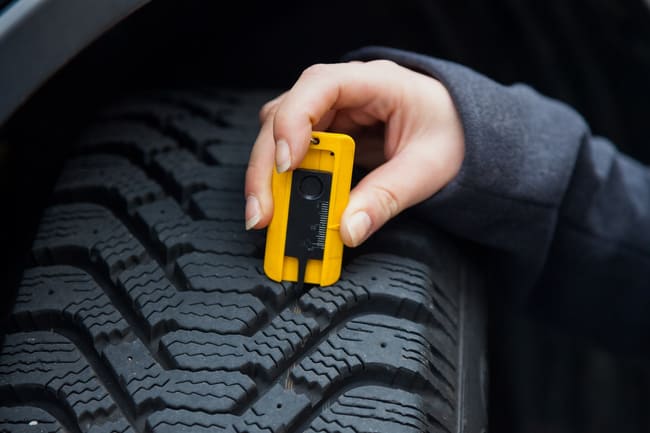
The tires are the only connection a vehicle has to the road. It is therefore not surprising that they must be in optimal condition in order to increase road safety and reduce the risk of accidents. In addition to the correct air pressure and the maximum age of 8 years, the correct tread depth of the tires is particularly important. Therefore, this should be measured regularly to ensure that the minimum depth is still reached. This is also recommended when choosing new tyres, especially if you choose used tyres. But why is tire depth so important? What is the minimum depth? Are there differences between summer, winter and all-season tires? And how can you check the tread depth? You will get an answer to all these questions in this article.
Contents
Why is tread depth so important?
Vehicle tires are among the parts that are exposed to the heaviest loads and make a decisive contribution to road safety. As classic wearing parts, their condition deteriorates over time and must be checked regularly.
The following factors can lead to premature and sometimes uneven wear:
- ! Tire pressure too low
- ! Dynamic or static Imbalance
- ! Brake system not working properly
- ! Incorrect setting of the axes
- ! Too much play the wheel bearing
- ! Heavily worn or damaged shock absorbers
As wear progresses, the tread depth of the tires is continuously reduced, which increases the braking distance and increases the risk of aquaplaning. New car tires usually have a profile of 8 to 9 mm (the tread depth of new truck tires is even between 14 and 22 mm). These enable optimal braking performance and ensure ideal driving behavior of the vehicle. In contrast, the braking distance with worn tires on a wet road is almost twice as long. For example, if you are only driving with a tread depth of 1.6 mm and want to brake at 80 km/h on wet roads, you will only come to a standstill 18.6 m later than with new tyres.
In addition, the lower the tread depth, the lower the grip on the road surface. This increases the risk of aquaplaning, as the tires with a lower profile are less able or unable to displace the water, causing the car to lose contact with the road and become unmanoeuvrable. Since this also increases the risk of an accident, worn tires also jeopardize insurance cover, since an accident in this case may be classified as gross negligence. For this reason, you also have to reckon with a fine of between 50 and 75 euros (depending on whether other road users were endangered or not) and a point in Flensburg if a police check found that the tread depth was too low.
What is the minimum tread depth tires should have in winter and summer?
According to the law, tires should have a tread depth of at least 1.6 mm, because less is no longer safe on the road. This minimum depth applies to passenger cars as well as trucks and motorcycles. For small and light motorcycles, even just 1.0 mm is sufficient. This regulation applies throughout Europe, although experts recommend replacing summer tires with a tread depth of 3 mm and winter or all-season tires with a tread depth of 4 mm for new ones, as traction is impaired much earlier in rain, snow and ice. According to the Road Traffic Licensing Regulations (StVZO), this value refers to the main profile, which makes up approx. 75% of the entire profile and is located in the middle of the tread.

A deeper profile is recommended for winter tires and for all-season tires that are usually also used in winter than for summer tires, since good grip is particularly important on snow and ice in order to shorten braking distances and improve cornering. The numerous sipes in the profile also contribute to this, which enable the tire to grip the road surface optimally even in ice and snow. A similar function is fulfilled by the additional transverse grooves in summer tires, which reduce the risk of aquaplaning, as water on the road can be drained through them.
How can I measure the tread depth of my tires?
You should check the tread depth regularly to ensure that your tires still have enough grip in the wet, snow and ice to avoid endangering you and other road users. You should measure the depth at different points on the tread, as in the event of a traffic stop by the police, the lowest measured value applies. You should also check them regularly, but at least when you change your tires every six months, as various factors can promote wear on your tires.
You can use different methods to measure the tread depth of your tires, depending on what you are doing have hand
- Tread Wear Indicators (TWI): These are small ridges built into the tire tread grooves by the manufacturer that act as wear indicators. Their position is usually marked with the letters TWI or the manufacturer's logo on the tire sidewalls. When these ridges are clearly visible, the purchase of new tires is urgently required, as the old ones have reached the minimum tread depth of 1.6 mm, which is already well below the professionals' recommendation.

- Mechanical or digital tread depth gauge: These are usually available at petrol stations, garages or specialist shops. They allow measurements accurate to the millimeter and are very easy to use. All you have to do is slide the dipstick into the tire tread and read the measurement result either on the scale or on the display.
- Folding rule or ruler: If you do not have a tread depth gauge available, you can also use a standard folding rule or a drawing ruler. However, you should make sure that the scale on the edge starts exactly at zero and there is not a few millimeters left.
- Euro coin: You can also use a 1 euro coin to measure the tread depth of your tires. Simply insert this into the profile groove. If you can see the golden rim (exactly 3mm wide), you should change your tires in the near future, as they still have the legal minimum tread depth, but are already below the recommended 3mm.
- < i class="as-icon as-icon--wrench"> Laser triangulation: This method is the most accurate and has the added benefit of detecting mistracking. This gauge is built into the ground and measures tread depth and wheel alignment as you drive your vehicle over it. This device is often used in workshops, as the tread depth of the tires is also checked by the TÜV as part of the regular main inspection.
Conclusion
When buying new winter tyres, they usually have a tread depth of between 8 and 9 mm. New all-season tires have the same tread depth, since they are also driven in winter. Summer tires, on the other hand, can only have a profile of 7 to 8 mm when you buy them new. These tread depths allow for optimal handling of your vehicle and an ideal braking distance. But over time, the profile wears out and the risk of an accident increases as a result, as the braking distance increases, cornering is impaired and road grip is reduced. It is therefore necessary to check regularly at least every 6 months whether the tire tread still meets the recommended minimum depth of 3 mm for summer tires or 4 mm for winter and all-season tires. You can use various methods to do this, although it is advisable to purchase a tread depth gauge, as these are usually not very expensive, but allow accurate measurements.
